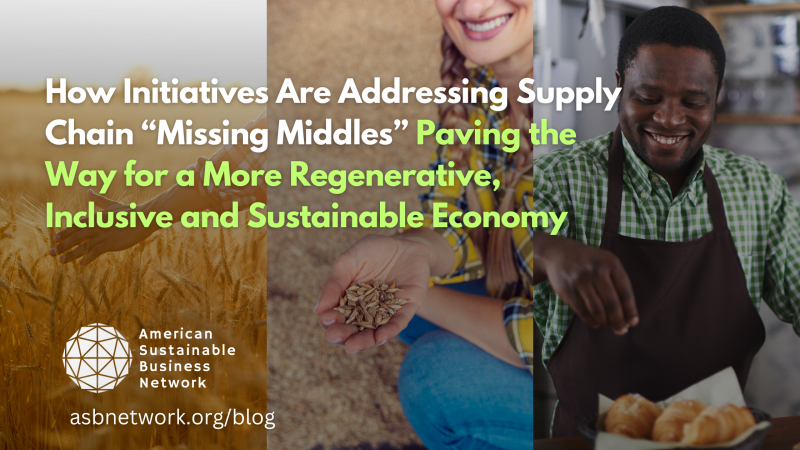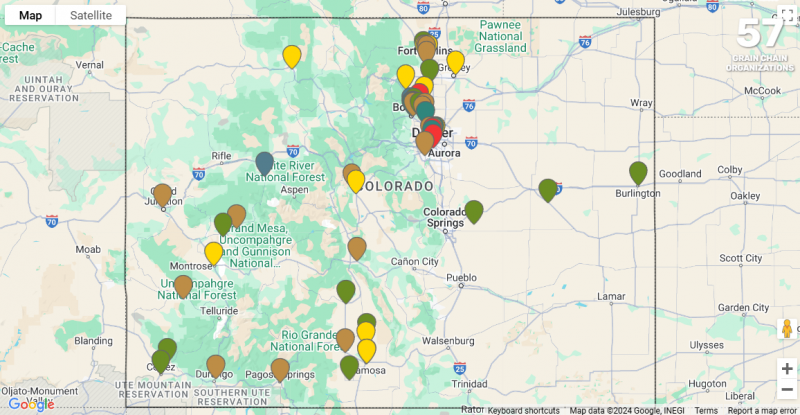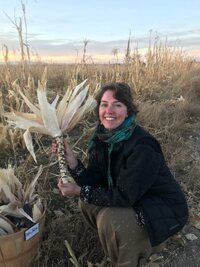How Initiatives Are Addressing Supply Chain “Missing Middles”
Paving the Way for a More Regenerative, Inclusive and Sustainable Economy

Over the last century, supply chains in the U.S. agricultural sector have experienced extreme concentration as small and mid-sized slaughterhouses, grain mills, and other processing and aggregation businesses closed across the country. This “missing middle” severely limits market access for independent farmers and ranchers, while also hindering opportunities for businesses creating new markets.
Initiatives Rebuilding the Missing-Middle
Many have devoted themselves to rebuilding these missing links: One such example is Growing GRASS, a USDA-funded project led by the American Sustainable Business Institute/Network and Other Half Processing that aims to build strong, resilient supply chains for the meat processing byproducts of regeneratively raised cattle and bison. The project’s goal is to increase the value and production of verified regenerative livestock and provide more climate-friendly materials for leather, ingredient, and pet food markets.
Another example is the Colorado Grain Chain (CGC), working to bridge the gap between Colorado grain growers and the businesses that rely on their products, with the goal of making it easier for small and mid-sized farms to access and thrive in these markets.

Building the Path to Market
Founded in 2019, the membership-based nonprofit’s goal is to reintroduce the grain production cycle to the region and support healthier preindustrial grain varieties. Today, it has a statewide network of more than 50 members and 1,200 subscribers, and the momentum is growing. The organization focuses on helping everyone along the supply chain. That includes the farmers at the beginning and the consumers and makers –– such as bakers, chefs, distillers and brewers–– at the end. It also includes those who process, store and distribute along the way, such as suppliers, food hubs, wholesalers, millers, and maltsters.

“You can’t keep growing or producing if you don’t have a path to market,” said Lisa Boldt, the Colorado Grain Chain’s executive director.
Expanding Local and Regional Infrastructure
The Grain Chain is part of a national movement to expand local and regional infrastructure to benefit small and mid-sized farmers. They often face challenges in bringing their products to market. To access processing for value-added products, farmers often have to truck crops and animals across long distances, adding significant operational costs. Concentration in supply chains allows large-scale monopoly processors and aggregators to push down prices for farmers. Just 14% of every food dollar goes to the farmer today. When larger farms produce on a larger scale, they’re able to boost their profit margins. Smaller farms can’t afford to do that.
Policies Expand Middle-Market Development
Policymakers have also recognized that small and mid-sized farms need help. For instance, the 2018 Farm Bill created the Local Agriculture Market Program to expand support for business and market development throughout local and regional value chains, according to the USDA’s Economic Research Service. The program focuses on grant funding to support and grow the local and regional economy. For example, a 2023 report to Congress highlighted the creation of over 4,000 food business enterprises and the creation of over 5,000 jobs in those sectors.
Building Support for the Grain Economy
The Grain Chain seeks to build and support a community focused on the grain economy. Its Grain Exchange Marketplace (GEM) connects farmers and businesses through an online database. Another effort, the Colorado Grown Grains Co-Brand, promotes awareness and demand for locally grown grains by offering a recognizable branding tool. The nonprofit also provides marketing, technical assistance and educational resources.
For the next three years, the Grain Chain will be running an Organic Grains Microgrant Program with USDA funding. The microgrants aim to help get locally grown, organic grains to market. This year, the focus is on helping those who process and store grain – the middle part of the supply chain.
Creating Pathways Between Growers & Businesses
Storage and processing, in particular, can be a bottleneck in the Colorado grain system, according to a 2022 white paper by Mad Agriculture, a Boulder-based regenerative agriculture nonprofit. After harvest, grain requires cleaning, storage and sometimes malting and milling before it’s ready for purchase. Much of today’s storage equipment is meant for commodity farmers who produce on a larger scale, so finding affordable and appropriate storage can be a challenge.

“In addition, heirloom and experimental grain varieties, such as millet, Kernza, or spelt, require specialized equipment,” said Audrey Paugh, CGC Communications and Events Manager. “The extra care and infrastructure can add costs.”
The nonprofit chose to start with processing and storage to create more pathways between growers and businesses. So far, the applications have included specialty equipment funding, grain-related education and packaging and branding support.
The Benefit from Increased Capacity
Increasing the capacity of the middle of the supply chain has benefits for makers as well because it helps ensure a steady, significant and quality supply. The quality and freshness of local grains can help craft specialized and novel food and beverages. Many consumers prefer locally grown products and products that support the local economy, according to a 2022 survey conducted by Colorado State University. Nationally, a 2020 USDA survey found that there is a $9 billion U.S. market for local food – grown within 400 miles of the end-user.
Further, local and regional supply chains are more resilient to disruption. In addition to her work with the Grain Chain, Boldt co-owns a brewery with her husband in the artsy college town of Fort Collins, Colorado. At Troubadour Maltings, they source all their grain regionally. They found they were better able to weather disruptions such as the COVID pandemic and the beginning of the war in Ukraine, which provides a large percentage of the world’s wheat, than some other breweries that depended on global commodity systems.
“Plus, if there’s variation in climate and weather in the area that affects yield,” Boldt adds, “we know in advance because there’s such an easy line of communication.”
Regenerative Practices Lessening Impacts of Climate Change
Many Grain Chain farmers hope to lessen the impacts of climate and weather by adopting regenerative practices, such as planting more drought-tolerant grain varieties such as millet and rye. Some of these grains have additional benefits for the farmer and the environment. Rye, for example, can be grown as a cover crop to help revitalize the soil after other crops have been grown. Its deep roots require less water use and help prevent soil erosion. As a cover crop, rye also creates an additional source of income when the field might otherwise lie fallow.
One Grain Chain member, Dry Land Distillers, recently released 100% Malted Ryman Rye Straight Whiskey. The whiskey is made with regenerative, organic rye grown by Jones Farms Organics, also a Grain Chain member farm. “The farmer, the distiller, the baker, the miller were all there in the same place,” Paugh said. “That’s how a lot of these connections form.”
Initiatives like the Colorado Grain Chain and Growing GRASS are paving the way for a more resilient, inclusive, and sustainable agricultural landscape. By addressing the “missing middle” in supply chains, these programs provide essential support for small and mid-sized producers, enabling them to reach new markets and build lasting partnerships. This not only strengthens local economies but also aligns with climate goals by fostering regenerative practices that prioritize land health and biodiversity. As more organizations and communities come together to rebuild these critical links in our food systems, we can look forward to a future where farmers and ranchers are empowered to thrive sustainably and profitably. Together, we’re redefining what’s possible in U.S. agriculture for a more just and sustainable economy.






